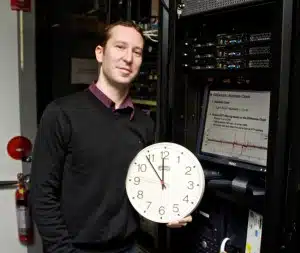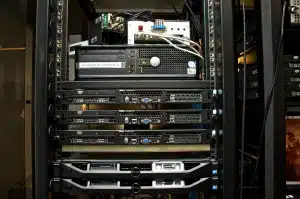Australian researchers have invented a new clock that will bring atomic accuracy to your desk.
Skype, online games, air traffic control, smart energy grids – all rely on accurate timing across the internet. But our present computers aren’t accurate enough. They can synchronise with an atomic clock over the internet. But even tiny delays across the network introduce errors – your video conversation gets out of sync, you lose your online game, or the electricity grid wastes power.
University of Melbourne engineer Julien Ridoux and his colleague Darryl Veitch have two solutions to the problem – install an atomic clock in your computer for $50,000, or use their new, free, software clock accurate to within a millionth of a second.
Known as RADclock, their new software has been so successful it is now being tested across Australia with the cooperation of the National Measurement Institute (NMI), the Institute for a Broadband-Enabled Society and the Australian Academic and Research Network (AARNet). The work is being presented for the first time in public through Fresh Science, a communication boot camp for early-career scientists held at the Melbourne Museum. Julien was one of 16 winners from across Australia.
“The techniques used in the past couple of decades are now not accurate enough to ensure the necessary coordination,” Julien says, “and the obvious solution of installing an atomic clock in each computer was neither affordable nor practical.”
The National Broadband Network promises a much faster internet leading to a new digital age. But, as the network accelerates, the time kept by computers has to become more and more accurate.
Right now, says Julien, most of us have computers that do not have enough to do. Soon, these computers will all be inter-connected by the NBN at very high speed. “This army of computers can collaborate to create new services and applications but only if they know who is doing what and, particularly, when. With a super-fast network, tasks occur more frequently, and that requires computers to track the passing of time much more accurately.
“We have designed the Robust Absolute and Difference clock (RADclock), a novel timing system, that is accurate, reliable and inexpensive. Under good conditions this achieves microsecond accuracy, which is as good as an atomic clock-enhanced computer. And it costs nothing to install.”

RADclock time servers used to test and assess the quality of the clocks (photo: Timothy Broomhead, The University of Melbourne)
Their software taps into the counting device already installed in each computer to keep track of how fast the quartz crystal timer is vibrating. But because individual counters are unreliable, the program samples and analyses time information from many computers across the internet, to construct a robust, precise and accurate picture of the passing of time. “It’s time-keeping using a brains trust, if you like – the computers talk to each other and adjust their clocks as a result,” Julien says.
The RADclock has been under development for the past 4 years. It is now part of the Ark infrastructure of the Cooperative Association for Internet Data Analysis (CAIDA) in California to monitor the Internet (see http://www.caida.org/projects/ark/).
An experimental network of RADclock reference clocks is being established in Australia with the cooperation of the NMI and AARNet. This is the first step towards a nationwide high-accuracy infrastructure that will allow any computer access to accurate time.
Julien Ridoux is one of 16 early-career scientists presenting their research to the public for the first time thanks to Fresh Science, a national program sponsored by the Australian Government. His challenges have included presenting his discoveries in verse at a Melbourne pub.
For further information, contact Julien Ridoux at jridoux@unimelb.edu.au
For more information and to trial the software, visit http://www.cubinlab.ee.unimelb.edu.au/radclock/









 Fresh Science is on hold for 2022. We will be back in 2023.
Fresh Science is on hold for 2022. We will be back in 2023.